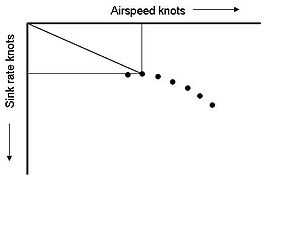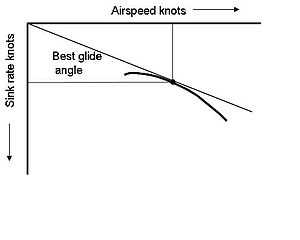Polar curve (aviation)
A polar curve is a graph which contrasts the sink rate of an aircraft (typically a glider) with its horizontal speed.


Measuring a glider's performance
Knowing the best speed to fly is important in exploiting the performance of a glider. Two of the key measures of a glider’s performance are its minimum sink rate and its best glide ratio, also known as the best 'glide angle'. These occur at different speeds. Knowing these speeds is important for efficient cross-country flying. In still air the polar curve shows that flying at the minimum sink speed enables the pilot to stay airborne for as long as possible and to climb as quickly as possible, but at this speed the glider will not travel as far as if it flew at the speed for the best glide. When in sinking air, the polar curve shows that best speed to fly depends on the rate that the air is descending. Using Paul MacCready's theory, the optimal speed to fly for best cross country speed may often be considerably in excess of the speed for the best glide angle to get out of the sinking air as quickly as possible.
Glide ratio
The glide ratio is expressed as the ratio of the distance travelled to height lost in the same time; it is expressed as the number of feet (or other length units) traveled horizontally during the time that one foot (or other length unit) of vertical distance is traversed. The ratio of the horizontal speed versus the vertical speed gives the same answer. (If the glider flies at 40 knots for an hour and experiences a 2-knot (4 km/h) sink rate, it will travel 40 nautical miles and descend 2 nautical miles (4 km). The glide ratio is 20 using both methods.
Effect of wind, lift and sink on best glide speed
The effect of wind, lift and sink on best glide speed is to move the curve within the plot by the amount of each component. That is, if flying into a headwind, with no vertical air movement, the curve would move left toward the origin by an amount equal to the velocity of the wind. The effect is the tangent line for best glide speed moves further down the graph for an increasing best glide speed but a lower best glide ratio. Thus, when flying into a head wind, the best glide speed is higher but the best glide ratio is lower. Conversely, for a tail wind, the polar curve moves away from the origin so that best glide speed is lower and the effective glide ratio is improved. In lift, move the curve up for a lower best glide speed and better glide ratio. In sink, move the curve down for a higher best glide speed and a worse glide ratio. The effect is that when flying between thermals, you would slow down in rising air and speed up when encountering sink. Wind with lift/sink would simply move the plot the according amount for each component.
Plotting the curve
By measuring the rate of sink at various air-speeds a set of data can be accumulated and plotted on a graph. The points can be connected by a line known as the ‘polar curve’. Each type of glider has a unique polar curve. The curve can be significantly degraded with debris such as bugs, dirt, and rain on the wing. Published polar curves will often be shown for a clean wing in addition to a dirty wing with bug splats represented by small pieces of tape applied to the leading edge of the wing.
The origin for a polar curve is where the air-speed is zero and the sink rate is zero. In the first diagram a line has been drawn from the origin to the point with minimum sink. The slope of the line from the origin gives the glide angle, because it is the ratio of the distance along the airspeed axis to the distance along the sink rate axis.
A whole series of lines could be drawn from the origin to each of the data points, each line showing the glide angle for that speed. However the best glide angle is the line with the least slope. In the second diagram, the line has been drawn from the origin to the point representing the best glide ratio. The air-speed and sink rate at the best glide ratio can be read off the graph. Note that the best glide ratio is shallower than the glide ratio for minimum sink. All the other lines from the origin to the various data points would be steeper than the line of the best glide angle. Consequently, the line for the best glide angle will only just graze the polar curve, i.e. it is a tangent.
External links
- Glider Performance Airspeeds An animated explanation of the basic polar curve, with modifications for sinking or rising air and for head- or tailwinds.
References
- Reichmann, Helmut (2005). Streckensegelflug. Motorbuch Verlag. ISBN 3-613-02479-9.